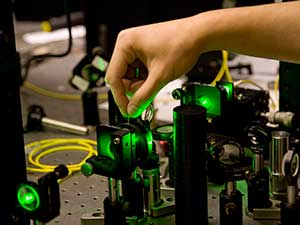
We are interested in developing a variety of biomedical photonic devices using principles, materials and structures that are biologically inspired or bio-engineered, implantable, biodegradable, wearable, and often mimicking nature at scales from nano to macro levels. Motivation of such devices is primarily for sensing, diagnostics, and therapeutics for applications in medicine, solving the limitations of conventional optical devices and conventional approaches. Often time, our work is driven by intellectual curiosity, even without specific applications in mind.
Bio lasers
 Since Theodore Maiman demonstrated the first laser a half century ago, stimulated emission and lasing have made a tremendous impact on modern science and technology. Although lasers and the coherent light they emit are omnipresent today, lasing has remained a man-made phenomenon. Generation of laser light has so far relied on artificial or engineered optical gain materials, such as doped crystals, semiconductors, synthetic dyes, and purified gases; biological materials and living organisms have not been explored as gain materials for lasers. This project introduces fluorescent proteins as a new optical gain material. The proposed research will investigate the optical amplification characteristics of biologically produced, biocompatible and biodegradable fluorescent proteins that have high quantum yield at various wavelengths across the entire visible spectrum. The fluorescent proteins offer unique properties not shared by any existing gain materials. For example, they can be expressed as functional transgene in a wide variety of organism. Intellectual merit of this project is harnessing these properties of fluorescent proteins to demonstrate novel photonic device concepts, including protein lasers in solutions and in condensed-state forms, as well as biological lasers based on single cells expressing fluorescent proteins will be explored. Successful completion of the proposed research will improve our ability to control and optimize the stimulated emission properties of fluorescent proteins and demonstrate miniature lasers and amplifiers built on the biological platform. Furthermore, it is expected to provide insights into a range of novel protein-based devices and technologies for practical applications. For example, lasing within the tissues and inside the cells may offer new possibilities of nonlinear deep imaging and intracellular sensing for bioengineering and medical diagnosis. The ability to generate laser light in vivo may enable new approaches in light-controlled therapy and drug activation.
Since Theodore Maiman demonstrated the first laser a half century ago, stimulated emission and lasing have made a tremendous impact on modern science and technology. Although lasers and the coherent light they emit are omnipresent today, lasing has remained a man-made phenomenon. Generation of laser light has so far relied on artificial or engineered optical gain materials, such as doped crystals, semiconductors, synthetic dyes, and purified gases; biological materials and living organisms have not been explored as gain materials for lasers. This project introduces fluorescent proteins as a new optical gain material. The proposed research will investigate the optical amplification characteristics of biologically produced, biocompatible and biodegradable fluorescent proteins that have high quantum yield at various wavelengths across the entire visible spectrum. The fluorescent proteins offer unique properties not shared by any existing gain materials. For example, they can be expressed as functional transgene in a wide variety of organism. Intellectual merit of this project is harnessing these properties of fluorescent proteins to demonstrate novel photonic device concepts, including protein lasers in solutions and in condensed-state forms, as well as biological lasers based on single cells expressing fluorescent proteins will be explored. Successful completion of the proposed research will improve our ability to control and optimize the stimulated emission properties of fluorescent proteins and demonstrate miniature lasers and amplifiers built on the biological platform. Furthermore, it is expected to provide insights into a range of novel protein-based devices and technologies for practical applications. For example, lasing within the tissues and inside the cells may offer new possibilities of nonlinear deep imaging and intracellular sensing for bioengineering and medical diagnosis. The ability to generate laser light in vivo may enable new approaches in light-controlled therapy and drug activation.
Biocompatible and biodegradable photonics
A variety of optical techniques in photomedicine require efficient delivery of light deep into and from tissues, but the limited penetration of light in tissue constitutes a serious constraint in clinical use. Fiber-optic devices or catheters have been useful in bringing a light source close to the target tissue in the body. However, delivering the light further into the tissue has remained a challenge. We are developing a new class of optical devices and previously unexplored approaches for therapy, surgery and diagnosis, as well as sensing.
Research Projects
- Brillouin biomechanical microscopy
- In vivo microscopy in mice
- Optical coherence tomography
- Bio-integrated Photonics













